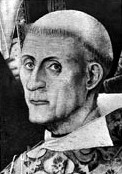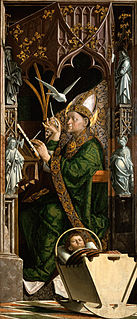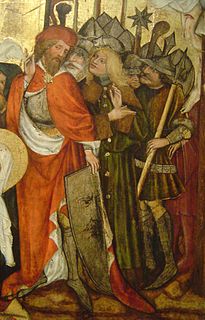
Matthias Grünewald was a German Renaissance painter of religious works who ignored Renaissance classicism to continue the style of late medieval Central European art into the 16th century. His first name is also given as Mathis and his surname as Gothart or Neithardt. Only ten paintings—several consisting of many panels—and thirty-five drawings survive, all religious, although many others were lost at sea in the Baltic on their way to Sweden as war booty. His reputation was obscured until the late nineteenth century, and many of his paintings were attributed to Albrecht Dürer, who is now seen as his stylistic antithesis. His largest and most famous work is the Isenheim Altarpiece created c 1512 to 1516.

Lorenzo Lotto was an Italian painter, draughtsman and illustrator, traditionally placed in the Venetian school, though much of his career was spent in other North Italian cities. He painted mainly altarpieces, religious subjects and portraits. He was active during the High Renaissance and the first half of the Mannerist period, but his work maintained a generally similar High Renaissance style throughout his career, although his nervous and eccentric posings and distortions represented a transitional stage to the Florentine and Roman Mannerists.

Stefan Lochner was a German painter working in the late "soft style" of the International Gothic. His paintings combine that era's tendency toward long flowing lines and brilliant colours with the realism, virtuoso surface textures and innovative iconography of the early Northern Renaissance. Based in Cologne, a commercial and artistic hub of northern Europe, Lochner was one of the most important German painters before Albrecht Dürer. Extant works include single-panel oil paintings, devotional polyptychs and illuminated manuscripts, which often feature fanciful and blue-winged angels. Today some thirty-seven individual panels are attributed to him with confidence.

Hugo van der Goes was one of the most significant and original Flemish painters of the late 15th century. Van der Goes was an important painter of altarpieces as well as portraits. He introduced important innovations in painting through his monumental style, use of a specific colour range and individualistic manner of portraiture. The presence of his masterpiece, the Portinari Triptych in Florence, from 1483 onwards played a role in the development of realism and the use of colour in Italian Renaissance art.

Bernt Notke (help·info) was a late Gothic artist, working in the Baltic region. He has been described as one of the foremost artists of his time in northern Europe.

Michael Pacher was a painter and sculptor from Tyrol active during the second half of the fifteenth century. He was one of the earliest artists to introduce the principles of Renaissance painting into Germany. Pacher was a comprehensive artist with a broad range of sculpting, painting, and architecture skills producing works of complex wood and stone. He painted structures for altarpieces on a scale unparalleled in North European art.
Francesco di Giovanni Botticini, commonly referred to as Francesco Botticini, was an Italian Early Renaissance painter. He was born in Florence and remained active as a painter until his death in 1498. He studied in the workshops of Neri di Becci, Cosimo Rosselli and Andrea del Verrocchio. He established his own Florentine workshop after a brief period as Neri di Bicci's assistant. Although there are few works attributed to Botticini directly, in recent years historians have unearthed of a considerable number of works that were certainly authored by Botticini. Since the assembly of the complete record of his works, he is viewed as a remarkable minor master of Renaissance Art.

The Master of the Třeboň Altarpiece, was a Bohemian painter active in Prague around 1380-1390. His name is derived from the Třeboň Altarpiece from the church of Saint Eligius at the Augustinian convent of Třeboň. The triptych depicts Christ on the Mount of Olives, The Tomb of Christ, and the Resurrection. It has been dated to around 1380, and is today held at the Convent of St. Agnes branch of the National Gallery in Prague.

The Master of the Saint Bartholomew Altarpiece was an Early Netherlandish painter active in Germany between 1475/1480 and 1510. Despite his anonymity, he is one of the most recognizable artists of the early Renaissance period in German art.
The Master of 1310 was an Italian painter active in Pistoia at the end of the 13th into the beginning of the fourteenth century.

The Master of Arguis was an Aragonese artist active in the first half of the 15th century. Stylistically, his work is related to that of Juan de Levi and Bonanat Zaortiga, and is derived from the tradition of the International Gothic in Aragon. His name is derived from a retable of Saint Michael dating to about 1440, now in the Museo del Prado in Madrid; this was once the main altarpiece of the church of Arguis. The painting depicts the victory of Michael over the Antichrist, and focuses primarily on the latter figure, pierced with a lance. Included in the scene are various secular figures, including kings and noblemen, as well as religious figures. At the bottom of the image may be seen a papal tiara and sceptre, symbols of the power the Antichrist claims to wield as the new Messiah. Two other paintings, both dedicated to Saint Anne, are attributed to the Master; one is in Barcelona, while the other, a small triptych, is in the collegiate church of Alquezar.

The Master of the Schöppingen Altarpiece was a German artist active in the area around Münster between 1445 and 1470. It appears likely that he studied in the Netherlands, and was influenced by the work of Robert Campin and Rogier van der Weyden. His name is derived from an altarpiece, dated to about 1470, that hangs in the parish church of Schöppingen. At the center of the painting is a depiction of the Crucifixion, along with four scenes from the Passion, which have been integrated into the background landscape. On the interior of the wings are eight more Passion scenes, while on their exterior are representations of the Annunciation and the Nativity. Of these, the former appears to have been derived from the Altarpiece of Saint Barbara painted by Campin, while the latter is an original composition.

Friedrich Herlin was a German painter. His earliest known work, depicting scenes from the Life of the Virgin, is dated 1459. A signature on an altarpiece in Nördlingen, dating it to 1462, identifies him as being from Rothenburg, as do citizenship documents from 1467. Nevertheless, it is possible that he lived there for only a short time, and that his origins lie in Ulm, where a painter named Hans Herlin lived and worked from 1449 until 1468. Stylistically, he borrowed much from Rogier van der Weyden, indicating a great deal of familiarity with the art of the Netherlands and of Cologne. The sculpture attached to the altarpiece of 1462, though officially listed as by the so-called "Master of Nördlingen", has been tentatively ascribed to Nicolaus Gerhaert, which if true would indicate extensive contacts to the highest artistic circles of the era.

The Master of the Rajhrad Altarpiece was a Bohemian painter active in the region around Olomouc and Brno before 1420. Likely of Moravian extraction, he derives his name from an altarpiece that once hung in the church of Saint Maurice in Olomouc; since disassembled, some of its panels are now in Rajhrad. These depict scenes from the Passion and from the Legend of the True Cross, and were painted before 1420. Two scenes, the Transportation of the Cross (Image) and the Crucifixion, are believed to be by his hand, while the rest are products of his studio. Also ascribed to him are the altarpiece of Náměšť, also dating to before 1420 and today found in Brno, and an Altarpiece of Saint Jacob of about 1430, today dispersed between Prague, Brno, Vienna and Nuremberg.

Hans von Tübingen was an Austrian artist.

The Master of the Legend of the Magdalen was an Early Netherlandish painter, active from about 1483 to around 1527. He has not been identified; his name of convenience is derived from a large, now-dispersed altarpiece with scenes from the life of Mary Magdalene, which has been dated to between 1515 and 1520 based on the costumes of the donor portraits. However other works attributed to him are extremely difficult to date with any accuracy. Many paintings have been linked with the triptych, which is thought to have been finished late in the artist's career. Other major works include his two Magdalen panels in London.

The Master of the Stauffenberg Altarpiece is a 15th-century Anonymous Master from Alsace or nearby who was stylistically influenced by Rogier van der Weyden.

Hans Brüggemann was a German artist who is remembered above all for the large carved altarpiece which now stands in Schleswig Cathedral.
Lambrecht is a Germanic given name originally meaning "famous in his land". It became popular due to Saint Lambrecht of Maastricht. Until after the Middle Ages it was more common in the Low countries than the Latinized equivalent name Lambert (us).



















